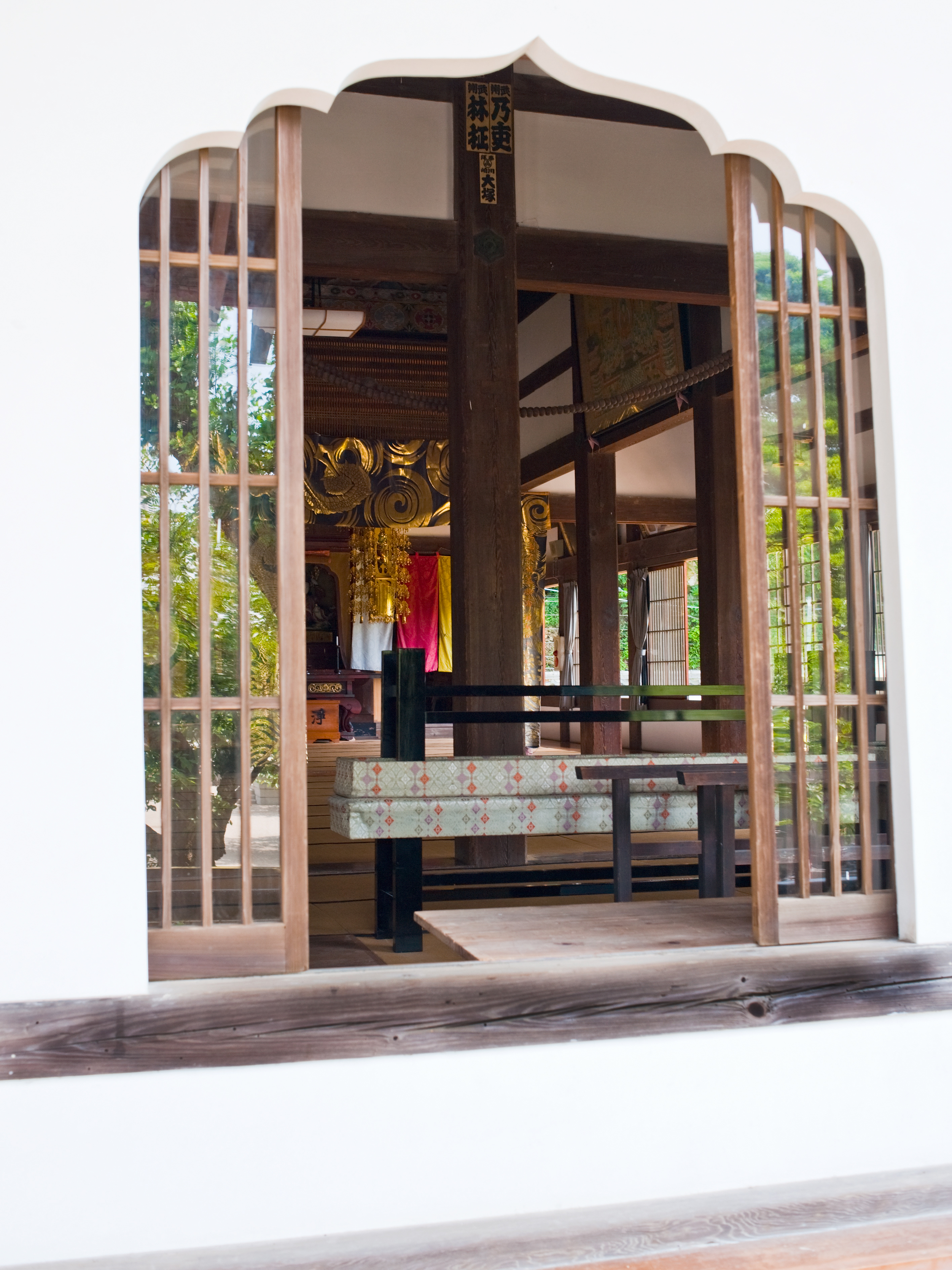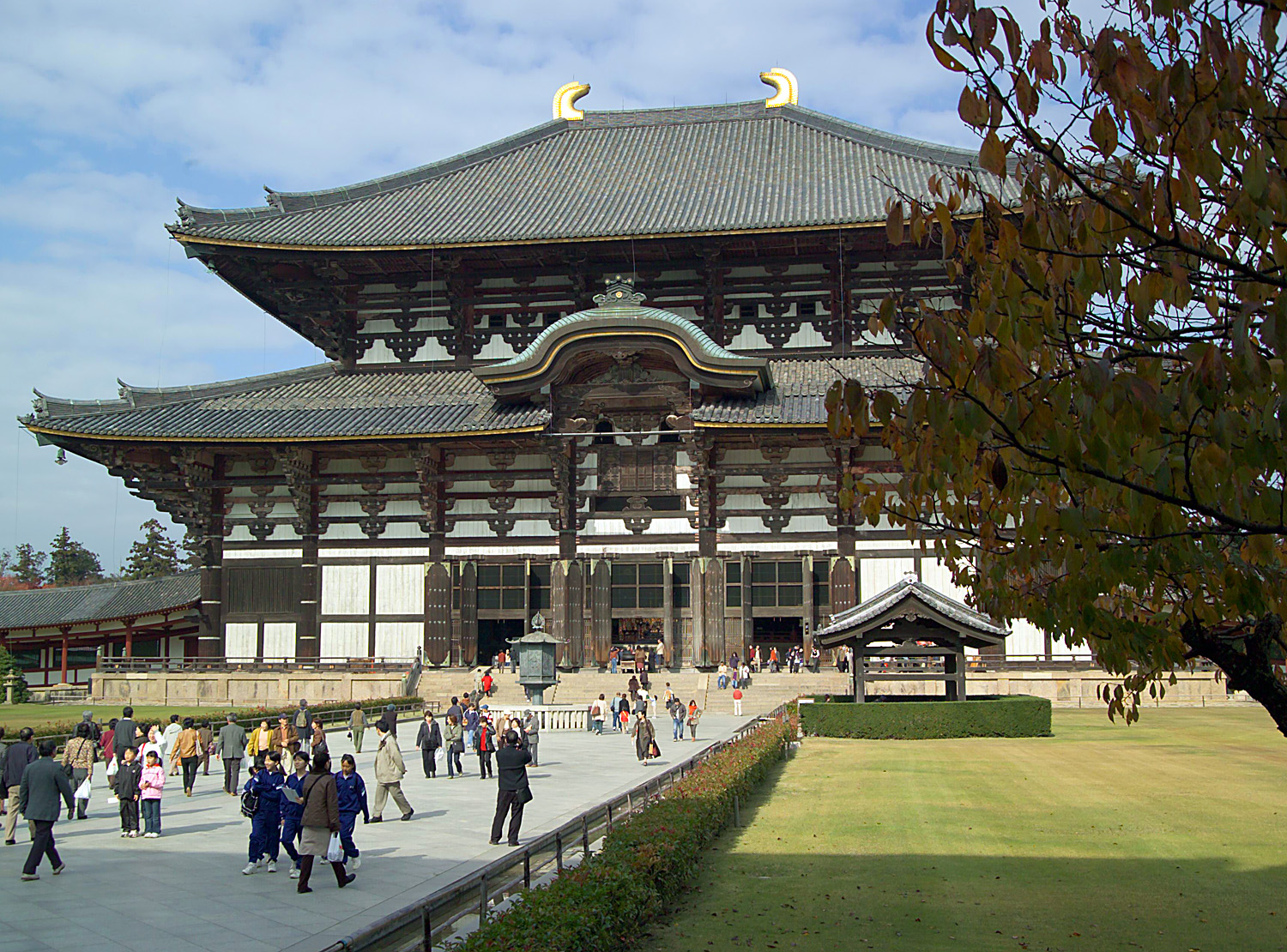|
Daibutsuyō
is a Japanese religious architectural style which emerged in the late 12th or early 13th century. Together with ''Wayō'' and ''Zenshūyō'', it is one of the three most significant styles developed by Japanese Buddhism on the basis of Chinese models. Originally called , because it had nothing to do with India it was rechristened by scholar Ōta Hirotarō during the 20th century, and the new term stuck. Ōta derived the name from Chōgen's work, particularly Tōdai-ji's Daibutsuden. Soon abandoned after its creator's death, probably because it didn't harmonize with Japanese tastes, it nonetheless influenced other building styles with its rational solutions.Nishi, Hozumi (1996:20-21) The combination of ''wayō'' and ''daibutsuyō'' in particular became so frequent that sometimes it is classed separately by scholars under the name ., p738/ref> This grandiose and monumental style is the antithesis of the simple and traditional ''Wayō'' style. The Nandaimon at Tōdai-ji and the Dō ... [...More Info...] [...Related Items...] OR: [Wikipedia] [Google] [Baidu] |
Zenshūyō
is a Japanese Buddhist architecture, Japanese Buddhist architectural style derived from Chinese Song Dynasty architecture. Named after the Zen, Zen sect of Buddhism in Japan, Buddhism which brought it to Japan, it emerged in the late 12th or early 13th century. Together with Wayō and Daibutsuyō, it is one of the three most significant styles developed by Japanese Buddhism on the basis of Chinese models. Until World War II, this style was called but, like the Daibutsuyō style, it was re-christened by Ōta Hirotarō, a 20th-century scholar. Its most typical features are a more or less linear layout of the shichidō garan, garan, paneled doors hanging from hinges, intercolumnar ''tokyō'', katōmado, cusped windows, tail rafters, ornaments called ''kibana'', and decorative pent roofs. Kōzan-ji's ''butsuden'' in Shimonoseki, Zenpuku-in's ''Dō (architecture), shaka-dō'' in Kainan, Wakayama and Anraku-ji's tō, pagoda in Ueda, Nagano, all dating to the Kamakura period, are cons ... [...More Info...] [...Related Items...] OR: [Wikipedia] [Google] [Baidu] |
Wayō
is a Buddhist architectural style developed in Japan before the Kamakura period (1185-1333), and is one of the important Buddhist architectural styles in Japan along with ''Daibutsuyō'' and the ''Zenshūyō'', which were developed based on Chinese architectural styles from the Kamakura period. This style originated in the Asuka period, Asuka (538-710) and Nara period (710-794), when Japanese studied Buddhist architecture of the Tang dynasty, and was improved in the Heian period (794-1185) to suit the Japanese climate and aesthetic sense. After the Kamakura period, the ''Wayō'' developed into the ''Shin-wayō'' style by combining it with the ''Daibutsuyō'', and further developed into the ''Setchūyō'' by combining it with the ''Zenshūyō'', and pure ''Wayō'' architecture decreased. Overview The name was coined later, during the Kamakura period when the other two styles were born. Because by then the style was considered to be native, the term started to be used to ... [...More Info...] [...Related Items...] OR: [Wikipedia] [Google] [Baidu] |
Tōdai-ji
is a Buddhist temple complex that was once one of the powerful Nanto Shichi Daiji, Seven Great Temples, located in the city of Nara, Nara, Nara, Japan. The construction of the temple was an attempt to imitate Chinese temples from the much-admired Tang dynasty. Though it was originally founded in the year 738 CE, Tōdai-ji was not opened until the year 752 CE. The temple has undergone several reconstructions since then, with the most significant reconstruction (that of the Great Buddha Hall) taking place in 1709. However, it was on the verge of collapse in the late 19th century due to the weight of its huge roof. The collapse was prevented through a first restoration (1904–1913), and its current appearance was completed using rebars and concretes between 1974 and 1980. Its Great Buddha Hall ( ''Daibutsuden'') houses the world's largest bronze statue of the Buddha Vairocana, known in Japanese as ''Daibutsu'' (). The temple also serves as the Japanese headquarters of the Kegon sch ... [...More Info...] [...Related Items...] OR: [Wikipedia] [Google] [Baidu] |
Setchūyō
is an architectural style born in Japan during the Muromachi period from the fusion of elements from three different antecedent styles: ''wayō'', ''daibutsuyō'', and ''zenshūyō''. It is exemplified by the Main Hall (Japanese Buddhism), main hall at Kakurin-ji.p=44/ref> The combination of ''wayō'' and ''daibutsuyō'' in particular became so frequent that sometimes it is classed separately by scholars under the name .p=738/ref> See also *Japanese_Buddhist_architecture#Heian_period, Japanese Buddhist architecture - Heian period *''Daibutsuyō'' *''Wayō'' *''Zenshūyō'' Notes Bibliography * * {{DEFAULTSORT:Setchuyo Japanese Buddhist architecture Japanese architectural history ... [...More Info...] [...Related Items...] OR: [Wikipedia] [Google] [Baidu] |
Nara, Nara
is the capital city of Nara Prefecture, Japan. , Nara has an estimated population of 367,353 according to World Population Review, making it the largest city in Nara Prefecture and sixth-largest in the Kansai region of Honshu. Nara is a core city located in the northern part of Nara Prefecture bordering the Kyoto Prefecture. Nara was the capital of Japan during the Nara period from 710 to 784 as the seat of the Emperor before the capital was moved to Nagaoka-kyō, except for the years 740 to 745, when the capital was placed in Kuni-kyō, Naniwa-kyō and Shigaraki Palace. Nara is home to eight major historic temples, shrines, and heritage sites, specifically Tōdai-ji, Saidai-ji, Kōfuku-ji, Kasuga Shrine, Gangō-ji, Yakushi-ji, Tōshōdai-ji, and the Heijō Palace, together with Kasugayama Primeval Forest, collectively form the Historic Monuments of Ancient Nara, a UNESCO World Heritage Site. Etymology By the Heian period, a variety of different characters had ... [...More Info...] [...Related Items...] OR: [Wikipedia] [Google] [Baidu] |
Japanese Architecture And Art Net Users System
Japanese Architecture and Art Net Users System, or JAANUS, is an online dictionary of Japanese architecture and art terms compiled by Dr. Mary Neighbour Parent. It contains approximately eight thousand entries. It is searchable in both English and romaji and contains many hyperlinks In computing, a hyperlink, or simply a link, is a digital reference providing direct access to data by a user's clicking or tapping. A hyperlink points to a whole document or to a specific element within a document. Hypertext is text with ... and illustrations. See also * Japanology References External links * Japanese studies Architecture in Japan Japanese art {{Japan-art-stub ... [...More Info...] [...Related Items...] OR: [Wikipedia] [Google] [Baidu] |
Japanese Buddhist Architecture
Examples of Buddhist architecture in Japan Japanese Buddhist architecture is the architecture of Buddhist temples in Japan, consisting of locally developed variants of architectural styles born in China.p=716/ref> After Buddhism arrived from the continent via the Three Kingdoms of Korea in the 6th century, an effort was initially made to reproduce the original buildings as faithfully as possible, but gradually local versions of continental styles were developed both to meet Japanese tastes and to solve problems posed by local weather, which is more rainy and humid than in China. The first Buddhist sects were Nara, Nara, Nara's six ,The six sects were called Sanron-, Jōjitsu-, Hossō-, Kusha-, Ritsu-, and Kegon-shū. followed during the Heian period by Kyoto's Shingon and Tendai. Later, during the Kamakura period, in Kamakura, Kanagawa, Kamakura were born the Jōdo and the native Japanese sect Nichiren-shū. At roughly the same time, Zen Buddhism arrived from China, strongly i ... [...More Info...] [...Related Items...] OR: [Wikipedia] [Google] [Baidu] |
Woodwork
Woodworking is the skill of making items from wood, and includes cabinetry, furniture making, wood carving, joinery, carpentry, and woodturning. History Along with stone, clay and animal parts, wood was one of the first materials worked by early humans. Microwear analysis of the Mousterian stone tools used by the Neanderthals show that many were used to work wood. The development of civilization was closely tied to the development of increasingly greater degrees of skill in working these materials. Among the earlliest finds of woodworking are shaped sticks displaying notches from Kalambo Falls in southen Africa, dating to around 476,000 years ago. The Clacton spearhead from Clacton-on-Sea, England, dating to around 400,000 years ago,Allington-Jones, L., (2015) ''Archaeological Journal'', 172 (2) 273–296 The Clacton Spear – The Last One Hundred Years the Schöningen spears, from Schöningen (Germany) dating around 300,000 years ago and the Lehringen spear from north ... [...More Info...] [...Related Items...] OR: [Wikipedia] [Google] [Baidu] |
Muromachi Period
The , also known as the , is a division of Japanese history running from approximately 1336 to 1573. The period marks the governance of the Muromachi or Ashikaga shogunate ( or ), which was officially established in 1338 by the first Muromachi ''shōgun'', Ashikaga Takauji, two years after the brief Kenmu Restoration (1333–1336) of imperial rule was brought to a close. The period ended in 1573 when the 15th and last shogun of this line, Ashikaga Yoshiaki, was driven out of the capital in Kyoto by Oda Nobunaga. From a cultural perspective, the period can be divided into the Kitayama and Higashiyama cultures (later 15th – early 16th centuries). The early years from 1336 to 1392 of the Muromachi period are known as the or Northern and Southern Court period. This period is marked by the continued resistance of the supporters of Emperor Go-Daigo, the emperor behind the Kenmu Restoration. The Sengoku period or Warring States period, which begins in 1465, largely overlaps ... [...More Info...] [...Related Items...] OR: [Wikipedia] [Google] [Baidu] |








